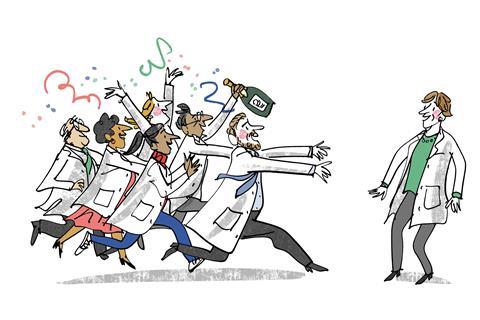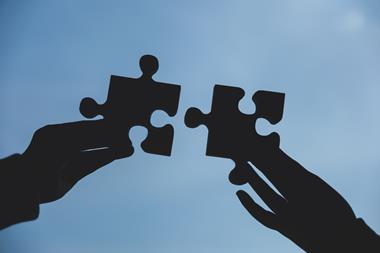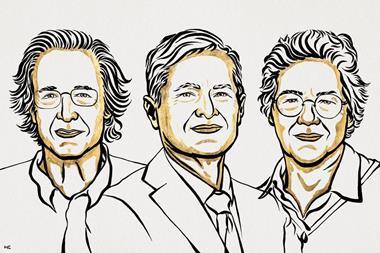Celebrations and support in the Bertozzi lab
There are few moments in science that usher in unbridled joy. Usually, successes must be tempered with cautious optimism and a level-headed vision of how to continue. On 5 October 2022, however, I and much of the chemistry world witnessed an outpouring of jubilation as Carolyn Bertozzi joined the hallowed halls of the Nobel laureates.
I was a postdoctoral fellow in the Bertozzi group from 2018 to 2023. Being at the epicenter of the excitement of the 2022 Nobel prize in chemistry announcement was equal parts surreal and yet, somehow, unsurprising. Carolyn has long been recognised across the disciplines of chemistry, chemical biology, glycobiology and beyond as a pioneer. Twitter polls and award tracking alone had been predicting that click chemistry and its uses in bioorthogonal chemistry would win at some point in the years to come, and that Carolyn would be among those recognised.

The term click chemistry is ubiquitous throughout molecular biology, biochemistry, and chemical biology fields, thanks to groundbreaking work from the Bertozzi group and others. Using click chemistry in biological systems without disrupting native, nontarget molecules, ie, bioorthogonal chemistry, has made over two decades of impact in basic science, and it is now entering the clinical world, too. All of this to say, Carolyn Bertozzi’s impact is not news to many. And for us who knew all of this before October 2022, it did not seem quite so crazy to think that the Nobel prize would one day come beckoning for her. For me, the surreality of it was that the person – my mentor – who I had met with for an involved one-on-one discussion just two weeks prior, was now a person that everyone in the science world was hoping to meet with, too.
I was a postdoctoral fellow in the Bertozzi group from 2018 to 2023. Being at the epicenter of the excitement of the 2022 Nobel prize in chemistry announcement was surreal, and yet, somehow, unsurprising. Carolyn has long been recognised across the disciplines of chemistry, chemical biology, glycobiology and beyond as a pioneer. Many people had predicted that the Nobel prize would one day come beckoning for her. For me, the surreality of it was that the person – my mentor – who I had met with for an involved one-on-one discussion just two weeks prior, was now a person that everyone in the science world was hoping to meet with, too.
So, what does one do when your mentor achieves such a feat? The first thing I did was unintentional – some version of exclaiming, ‘She did it!’ woke my partner (luckily, her sleepy disgruntlement quickly transitioned into excitement, too). Second, I sent Carolyn a congratulatory text, joining the chorus of thousands that must have turned into an hours-long, continuous notification on her phone. (I still make sure to slip in the detail to anyone who will listen that I was able to text a Nobel laureate the morning of the announcement.) Third, I turned to social media, where celebration had already begun. Tweets and retweets, comments and likes – they were already flooding the feeds of any channel I checked. The group emails and messages between members were also streaming in at a high clip, making it a very inconvenient day to have forgotten to charge my phone.
The rest of it you may have seen online. Hundreds of people gathered in the Sarafan ChEM-H building on Stanford’s campus to welcome her; Carolyn popping a bottle of champagne as the crowd cheered her on. As you can guess, not a lot of science was done in that corner of campus that day.
Celebrations continued in the days, weeks and months that followed. Part of this is because Carolyn is easy to celebrate. She has made a career of saying, ‘Yes, come join us!’ to scientists from all walks of life, and importantly, she has been intentional in cultivating this environment. Now she uses her Nobel platform to further include voices that are not always heard. It may also be obvious to those who have not interacted with her personally, but for me, it has been inspiring to watch her recognise this moment and directly choose rhetoric to include and uplift those beyond herself, even as so many in the community send praise her way. Perhaps one of my favorite parts of being a member of her lab during this Nobel season is how much I continue to learn about her perspective each time she presents, even though I have seen her give talks countless times.
The Nobel announcement also validated several years of my not-so-slightly-veiled boasting about my proximity to scientific impact. When friends and family outside the research world would ask what I do, I would oblige with my best explanation of glycobiology, cell surface interactions and mass spectrometry. Invariably, though, I would also discuss Carolyn. No matter who the audience, I would usually say, ‘She is going to win a Nobel Prize one day. No doubt.’ More often than not, this brought some incredulous eyebrow raises, but I no longer have to rely on supposition.
I think many of us who have been in the Bertozzi sphere felt this way. We are especially glad she is now cemented in the highest echelons of public recognition a scientist can achieve. Self-servingly, her success also helps us qualify our science to others. Knowing Carolyn, though, she would be happy about that. She sees herself a launching pad to propel us as far as we can go.
Interacting with her is an experience that usually leaves you better than before you met with her
I will give one last example of what it is like to be in Carolyn Bertozzi’s group. Each member likely has a story of how Carolyn supported them in a time of struggle. Mine came in the same time frame as the 2022 Nobel prize.
My mom had been battling pancreatic cancer for three years, and things were taking a turn for the worst in September 2022. Carolyn did not hesitate to support me when I asked her if I could fly home to Kentucky with no return trip booked. There was no concern for the lost time in the lab; that will figure itself out, she said. She emphasised the importance of me being where I needed to be. She was right; I was able to be with my mom for the last two weeks of her life, and those times are moments I will cherish forever.
My mom passed away on 2 October, days before Carolyn was announced as a Nobel Laureate. Carolyn and I were not able to directly communicate until a few days after the announcement. Her first concern when we connected again had nothing to do with the science’s world’s attention that was trained on her. Instead, she asked me, ‘How are you doing? How can I support you?’ It is that grace and supportiveness that will stick with me the longest. It is how I aspire to interact with my trainees, now that I have started my own group. I see that as part of the Bertozzi legacy to carry forward.
So many scientists, from friends and collaborators to people I meet at conferences, have told me they would like to meet Carolyn because she represents so much of what they respect about science. I confirm for them that getting to interact with her is an experience that usually leaves you better than before you met with her. And then I say with a wry smile, ‘If you need me to send her a text for you, just let me know.’
Kidding, kidding. (Mostly.) Instead, I say, ‘She has done a lot for me and for so many others, and she does not appear to be slowing down any time soon.’












1 Reader's comment